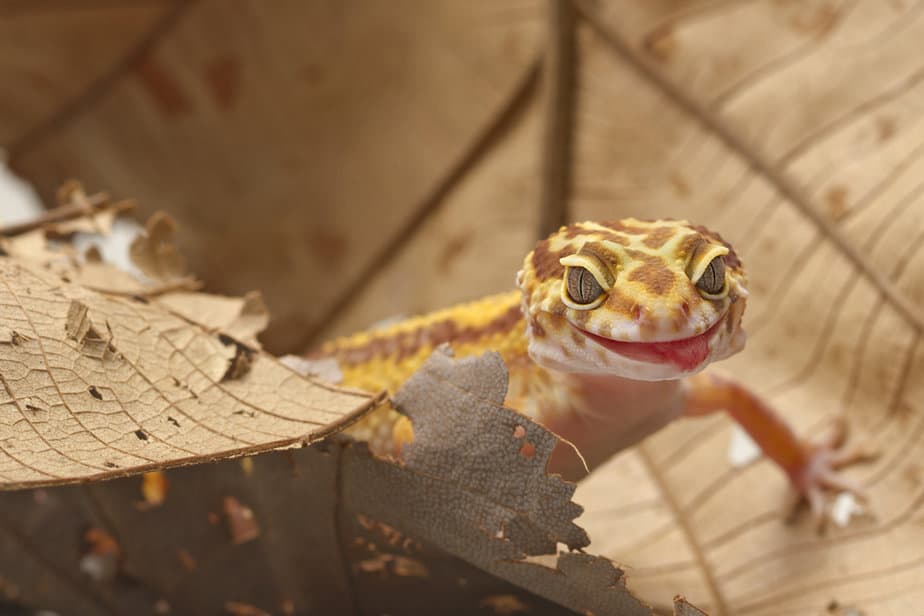Dehydration in leopard geckos can lead to kidney failure, shock, acidosis, heart failure, and even death. But how can you tell if your leopard gecko is dehydrated?
How to tell if your leopard gecko is dehydrated

Dehydration is the process by which an organism loses or uses more water than they take in.
This can happen to animals of all kinds, leopard geckos included. To tell if your leopard gecko is dehydrated, look out for symptoms like:
- Flexible eyelids
- Shedding problems
- Lack of skin elasticity – this is particularly noticeable on the sides of the leopard gecko’s body
- Lethargy
- Sunken eyes
- Constipation
- Puckered, dry, or wrinkled skin
- Flaky skin
- Sticky mucus membranes – these are located in the mouth’s lining
- Tenacious saliva – this is usually dry and ropy
- Dry membranes
The more dehydrated your leopard gecko is, the more severe the symptoms. Generally, there are three levels of dehydration. These are:
- Mild dehydration – reptile has lost less than 5% of its body weight in water
- Moderate dehydration – reptile has lost 5% to 9% of its body weight in water
- Severe dehydration – reptile has lost 10% to 15% of its body weight in water
What causes dehydration in leopard geckos?
The main causes of dehydration in leopard geckos are:
- Lack of drinking water – your leopard gecko will get dehydrated if you don’t provide enough water. So ensure that its bowl is always filled and observe its drinking habits to figure out how you can improve water uptake
- Inappropriate tank temperatures – consistent high tank temperatures can make your leopard gecko lose body water and become dehydrated.
- Inappropriate humidity levels – Low humidity levels in your leopard gecko’s tank can easily cause dehydration. This commonly happens when the tank substrate absorbs the moisture in the air.
- Illness – diseases that make your leopard gecko refuse to eat, vomit, and diarrhea can cause dehydration and even weight loss.
How to treat dehydration
If you suspect your leopard gecko is dehydrated, you must immediately take them to the vet. Only a professional can quickly determine the dehydration severity and recommend an appropriate rehydration technique.
Vets and other professionals can determine the severity of your reptile’s dehydration by determining how much weight they have lost and conducting blood tests.
Common blood tests used for this purpose include blood urinary nitrogen (BUN), packed cell volume (PCV), and total proteins (TP) tests.
Once the diagnosis is complete, vets may recommend treating mild dehydration by soaking your leopard gecko in some lukewarm water.
They may also advise you to mist such a gecko tank daily and ensure it always has a bowl of water.
On the other hand, moderate dehydration can be treated by offering more fluids orally or soaking the leopard gecko for longer.
If your reptile is severely dehydrated, the best way to treat them is by administering fluids using an injection.
Your vet may do this themselves or give you instructions to do it by yourself.
Whatever the case, always follow your vet’s instructions to the letter. This will keep you from administering too much fluid or making matters worse.
If there’s one thing that you should know about the fluids that are usually administered to leopard geckos, it’s that they can be electrolyte solutions instead of water.
These solutions can be made of Ricelyte, Pedialyte, or even sports drinks. Apart from the methods outlined above, these fluids can be administered by:
- IO fluid administration is a method of administering fluids directly to your reptile’s bone canal. It’s usually reserved for severely dehydrated reptiles. It may require prior sedation. Apart from dehydration, IO fluid administration can also help leopard geckos who are dealing with shock and extreme volume depletion.
- Orogastric tube feeding – this involves using a catheter to deliver fluids directly into your leopard gecko’s gastrointestinal tract. Clinicians can do this to help a severely dehydrated reptile or one who is struggling to eat
How do vets calculate fluid volumes to administer to dehydrated leopard geckos?
If your vet decides that the best way to treat your leopard gecko’s dehydration is by administering fluids orally or through catheters, they will need to calculate appropriate volumes.
A common way that these professionals do this is by allocating 10ml to 30ml of fluid per kilogram of gecko per day.
An alternative route is allocating fluids weighing 2.5% to 3.5% of your leopard gecko’s body weight per day.
Whichever route your vet goes with, you will have to give these fluids to your leopard gecko for 2 to 4 days.
How to prevent dehydration in leopard geckos
Since dehydration can be fatal, preventing it rather than treating it is better.
Fortunately, preventing this condition isn’t that difficult. Just follow the tips below:
- Provide feeder insects that are rich in water – you can even soak these insects in water before offering them to your leopard gecko.
- Wash your reptile’s water bowls regularly and fill them daily to encourage drinking. Don’t use hash soaps and chemicals on the bowls though – their smells can discourage your reptile from drinking water.
- Ensure tank temperatures and humidity levels are appropriate
- If your leopard gecko is an adult, ensure you mist its tank once or twice a week.
- Provide lukewarm water that your leopard gecko can occasionally soak in
Final thoughts
When it comes down to it, it’s quite easy to tell whether your leopard gecko is dehydrated.
The signs are usually clear, and some are even similar to those that other dehydrated animals exhibit. If you notice several of them, take your reptile to the vet and follow the instructions they will give you.
With any luck, your leopard gecko can recover within a few days.
